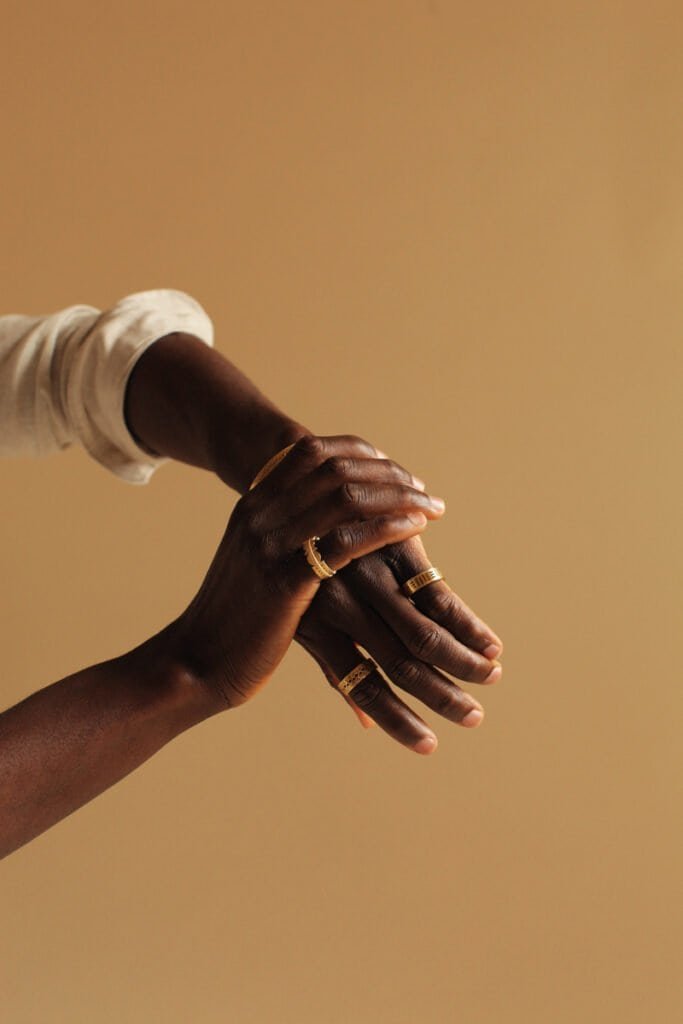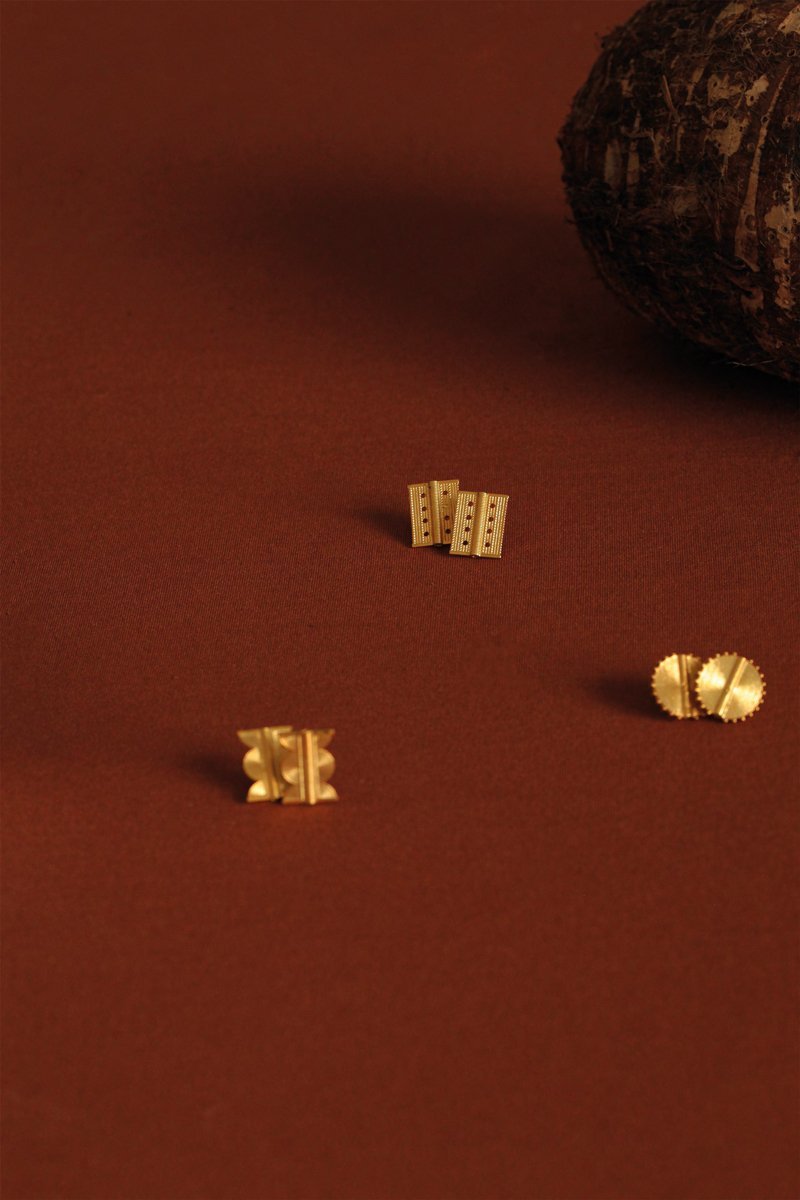Cultural heritage and social responsibility are at the heart of Ashley Alexis McFarlane’s designs for Omi Woods jewellery
Like many members of the African diaspora, Toronto-born Ashley Alexis McFarlane could not be precisely sure where her ancestors were from before they came to Canada via Jamaica. It is a mystery that has led her to explore many different facets, aspects and symbols of African culture as a designer, since 2010 with clothing and since 2018 with the African-inspired fine jewellery she has created under the Omi Woods brand.
Describing her pieces as contemporary heirlooms that celebrate connections to Africa and its diaspora, Ashley uses jewellery to express her creativity and personality, but also to explore African history, encouraging customers to think about place, the past and possible futures. The jewellery is handmade in Toronto, using recycled fine metals and ethically sourced gold from Africa.


“There’s not a lot of fine jewellery made with a view to the African diaspora,” says Ashley. “A lot is costume jewellery, large and elaborate pieces made with mystery metals. My parents are from Jamaica. We don’t have many jewellery traditions in the Caribbean, but I have always been interested in African culture and tradition. Designing jewellery was a way to explore these different cultures that interested me and learn more about myself.”
Like Ashley, the highly skilled Omi Woods artisans come from diverse backgrounds, with ancestries that stretch from the Middle East, Africa, Asia, South America and Eastern Europe – places where jewellery techniques have been long established and handed down through generations, reaching to descendants in Canada. “The craftspeople who make our jewellery are all local and many families have been in the industry for generations,” says Ashley. “Most major cities have a jewellery-making community. People know each other, so it’s a small and interconnected group.” Ashley has discovered that many jewellery-making techniques and styles still used today originally came from Africa, as that is where the earliest jewellery traditions can be found, including granulation and casting techniques.
“Our own pieces have a vintage look combined with contemporary minimalism that makes them perfect as elevated everyday wear,” she says. Some of the most popular pieces include gold necklaces featuring coins, symbols of West and East Africa, the Caribbean and African America, and items from nature such as tropical flowers and cowrie shells. The collection, which also includes bangles, earrings and rings, can be explored geographically, through items related to North Africa, for example, or thematically, as with pieces that incorporate the Adinkra symbols of the Asante.

As well as her interest in Africa and the Caribbean, Ashley is inspired by the detail and craft of vintage objects, clothes and cars. “When I look at classic cars, I marvel at the detail that goes into elements as grand as the engines and as elegant as the door handles,” she says. “The time put into crafting and considering something that will be a part of someone’s everyday life for a long time, because it is so beautifully made, is the epitome of vintage to me. Similarly, with Omi Woods, there is an elegance to each piece, to how it becomes party of your daily life and elevates it. That, for me, is luxury – things that add a specific quality to your life by fluidly combining design, craftsmanship and material.”
At the heart of Omi Woods jewellery is a desire to create beautiful, sustainable pieces, and to encourage people to consider the historic relationship between colonisation and industrialisation. “As we move forward and look at the electrification of vehicles and a new era of industrialisation, we still see the exploitation of indigenous communities for mineral resources,” says Ashley. “But the bigger picture of climate change goes beyond race. It no longer divides us on the basis of race, ethnicity or, in some ways, social economics, because inevitably climate change impacts all of us. I hope we learn to balance technology and progress with a need to live responsibly.”
In using primarily recycled precious metals, but also small amounts of traceable, ethically mined and conflict-free gold, Ashley encourages people to think about sourcing past and present – and how the world must find ways to extract commodities in better, fairer ways. “For me, it is about striving for an ever more perfect balance between humanity and nature while still enjoying the things we’d like to enjoy.”

Through taking a DNA test, Ashley discovered she is descended from the Bamileke people of Cameroon, who went to West Africa from the Nile region of what is now Sudan. “That means my DNA can be traced to regions that have strong silver and goldsmith cultures,” she says. “My family was likely enslaved because of gold – a lot of Africans were. I want to make jewellery that is sensitive to that history and connects us to our ancient past.”
Having started to wear jewellery inherited from her grandmother, Ashley has become increasingly drawn to gemstones. She is currently studying gemmology and has begun to introduce gems such as rubies and sapphires into her new collections. “I want to put together pieces with gemstones that pair well with our current designs, but also to tell a personal story,” she says. “I want to incorporate some of the gemstones used in ancient times in a way that is more customised, so our customers can select and create their own evolving story.
“Gemstones are piezoelectric. They conduct energy. They also hold memories and can tell a family story and that interests me a lot. When I look at my grandma’s gemstones, I reflect on them in terms of family history and that notion of passing on an item of jewellery to your children in a way that helps them in their own journey.” Ashley recently found that sapphires can be found in abundance in Cameroon and East Africa, the place her maternal line descends from, according to the DNA records. “My grandma would never have known,” she says, “but maybe she did in some ways and left small heirlooms for me to keep piecing together our family story. That has always been the power of jewellery.”
Visit www.omiwoods.com












